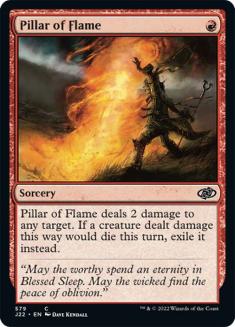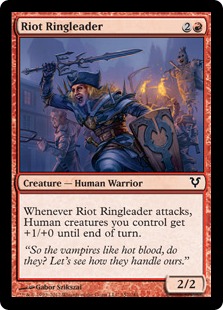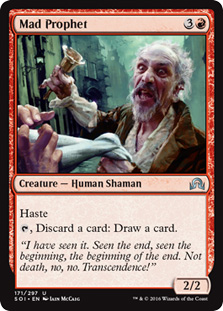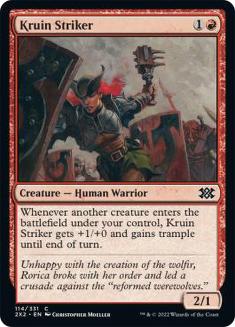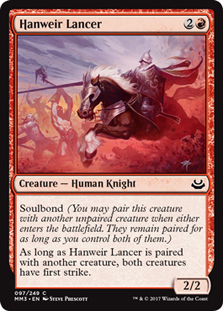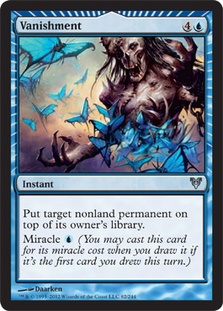This past weekend Grand Prix Vancouver happened, and nobody cared.
Okay, that’s not entirely fair. I imagine champion David Stroud probably cared, and likely so did runner-up Jeremy Schofield, who came a single match win away from a perfect 18-0 run. Marcin Sciesinski and Steven Riecken both probably cared about their Top 4 finishes that earned them invitations to the Pro Tour, and they all deserve congratulations for their performances. But GP Vancouver came at the tail end of an unpopular Limited format. I can’t recall a recent set that has been received as poorly for Limited as Avacyn Restored, and in fact, quite a few pro players chose to sit the tournament out rather than travel to Canada to play.
Many point to the lack of accomplished pro players in the Top 8 of the Grand Prix as an indication that the format doesn’t sufficiently reward skill. It is true that this is the first Top 8 in recent memory that didn’t include any players with previous GP or PT Top 8 finishes. It’s also true that this isn’t an isolated incident—GP Malmo, which was also Avacyn Restored Limited, saw only Samuel Estratti in the Top 8, with many pros who went straight to Sweden after PT Barcelona failing to so much as make Day 2. Then again, Paul Rietzl, Sam Black, and I were all just outside the elimination rounds in Vancouver, so if just a match or two had gone differently the narrative might be altered.
Personally, I don’t think people have given the format an entirely fair shot. I think some people came to negative conclusions about it early on and that perception became common wisdom via the echo chamber of the Internet. I certainly think that the format has issues and I’ll freely admit that it doesn’t hold a candle to Innistrad, but that may have been the best Draft format of all time, so the comparison isn’t really entirely fair. Is Avacyn Restored really a failed Limited set, or are we all just spoiled by recent history?
Lots of people seem to complain about the set without really vocalizing what they dislike about it. When pressed for reasons, many people seemed to fall back on fairly typical criticisms of Limited in general like “bombs are too good” or “high variance” and the like. In fact, I heard a number of people give completely opposite answers from one another like “too dependent on curve and too hard to come back from behind” and “the format is too slow and dominated by bombs.” Many people suggested that the format didn’t have enough depth, and they felt like they figured it out quickly and then got bored of it.
Figured it out quickly? Really? Just this weekend after GP Vancouver, I was having a conversation with Tom Martell, Jeff Cunningham, and Aeo Paquette—three players with a significant amount of high-level tournament success—and we couldn’t even agree on the best red common. In fact, not only could we not agree on the best, but we had vastly different ideas about the order of the rankings of the top five!
Here, you try it:
First pick, first pack, which of these do you most want to take? If you had to rank them in order of preference, how would you do it? When I asked this at the Grand Prix, there was absolutely no consensus. Different people had every one of these cards as number one, and the comparative rankings varied wildly.
And it’s certainly not just red. I saw Owen Turtenwald review of the white commons posted early this week, and with the exception of Seraph of Dawn at the top of his list, I didn’t agree with a single other part of his pick order. He ranked Righteous Blow and Defang highly, while I almost never end up with either in my decks. He ranked Thraben Valiant near the bottom, while I pick him highly. Perhaps the only thing we had in common was an affinity for Zealous Strike, which many other people seem to dislike.
What’s my point? If Avacyn Restored Limited were as shallow, uninteresting, and so easily solved a format as people seem to claim, how is it that so many top players disagree so dramatically on things so fundamental as common pick orders?
Now, don’t get me wrong. I do think there are legitimate issues with the format. I just think there’s been something of a bandwagon effect of people complaining about it that has led to it getting a worse rap then it deserves. Once a few notable pros badmouthed the format, it seemed like the floodgates opened and suddenly people are making hyperbolic claims like it’s a worse Draft set than Homelands.
What do I think the major issues with the format are? Well, they’re all interrelated, but they are mostly based on the wide band of power levels among the cards in the format. Every format is going to have more and less powerful cards, certainly, but Avacyn Restored has a particularly high number of very weak cards compared to recent sets. Just in red, there’s Battle Hymn, Banners Raised, Dangerous Wager, Demolish, Malicious Intent, Raging Poltergeist, and Uncanny Speed that are very hard to fit into a deck!
While I can appreciate the occasional format in which we have to scramble for playables rather than find the best way to build a deck from our embarrassment of riches, the reality is that drafting these formats often seems more scripted because it’s tough to veer too far from your early picks for fear of ending up without enough cards to build a deck. Abandoning your first few picks to jump into a new color or archetype can easily leave you scrambling not just for that 23rd card, but for cards 19-22!
This issue is exacerbated by how heavily reliant many cards are on specific synergies. The most notable of these cards is Thatcher Revolt, which has entire decks built around it and was described by Mark Rosewater in his design preview article as one of the lynchpins of the set. A deck with, say, two Kruin Strikers, two Riot Ringleaders, and a Goldnight Commander wants just about as many Thatcher Revolts as it can get. For a deck without these cards or very much like them, it’s barely playable.
I’m not saying we don’t want cards like Thatcher Revolt. Far from it, in fact—cards whose values change dramatically based on what the rest of your cards are doing are the most interesting kind of Limited cards. They’re what make Limited about building decks rather than just taking the “best” card every time. In combination with a high percentage of low power cards, though, these heavily synergy reliant cards make it that much more difficult to fill out a deck and cause individual games to feel that much more high variance.
This feeling is furthered by the huge power level gulf between the best cards and the worst cards, even among those players would generally include in their decks. Cards like Trusted Forcemage, Mist Raven, and Seraph of Dawn and just head and shoulders above everything else, to say nothing of uncommons and rares like Druid’s Familiar and Wolfir Silverheart. When one player draws the top half of their deck and the other player draws the bottom half, games are an absolute slaughter—there’s very little one can do about Wandering Wolf into Trusted Forcemage into Mist Raven.
Many players have complained about the lack of quality removal in the set. While it’s clearly a very intentional decision to allow for soulbond to shine as a mechanic—Doom Blade would simply be way too good and make soulbond far too unreliable—it also makes it extremely difficult to come back from these kinds of starts because you have to try to fight creatures with creatures. Bone Splinters is one of those cards that relies upon synergy to actually be good; if you don’t have a Butcher Ghoul to go with it, you’re not really getting yourself out from behind.
Even the only common bounce spell in the format—Peel from Reality—requires you to already have a board presence to use it, so it’s generally best when you’re ahead (and that much better at driving the nail into the coffin when the creature of your own that you’re bouncing is a Mist Raven!). I think a lot of people felt like Avacyn Restored was going to be the next Rise of the Eldrazi when they saw all the big Angels in the set, and they were disappointed to find that it’s actually much closer to Zendikar in the way the games play out.
While I actually enjoy what the miracle mechanic adds to Magic, I’m sympathetic to the fact that it adds yet another very in-your-face random element to a format with a lot of variance. I do think that the way miracles play out are often very fun, and I think many of them actually take quite a bit of skill to play optimally—despite what many players seem to think, it’s certainly not always correct to fire off Blessing of Nature or Vanishment or Banishing Stroke right away. That being said, I think people would appreciate them more in the context of a different set; one that didn’t give them so many other reasons to bemoan their misfortune.
All told, I enjoyed Avacyn Restored, at least in Draft. It certainly had big shoes to fill coming on the heels of Innistrad and Dark Ascension, and it may not have been up to the task, but I think it got more flak than it deserved. Sealed deck, though, probably deserved all the hate it got—but hey, I’m one of the lucky ones who opened Wolfir Silverheart and Druid’s Familiar in Vancouver, so I’m happy! I’m certainly looking forward to M13, but more for something new rather than because I feel AVR was such a failure.
But enough about that; on to something everyone can agree is awesome: the Magic Pro Tour Hall of Fame! Ballots went out and statistics on all of the eligible players were posted over the past week, so the Internet has been abuzz with discussions on who should and should not get in and why.
I haven’t decided on my exact ballot just yet, but I’m close. Here are my thoughts on the candidates who I think are reasonable choices:
Paulo Vitor Damo da Rosa
Paulo is as obvious a choice for the Hall of Fame as they get. Not only does he have an astronomical number of PT Top 8s, but he’s also an excellent strategy writer and a positive role model in the community. It’s funny for me to look back at when Paulo started playing on the PT and we used to make fun of Antonino for no longer even being the best De Rosa on the train. How far we’ve come.
Kenji Tsumura
Kenji’s period of dominance lined up pretty much exactly with my time away from the game, so I never got a chance to watch him play in his prime. That said, his numbers from his brief career are downright amazing, and people whose opinions I greatly respect speak highly of his play. I’ve also been fortunate enough to be able to hang out with him during some of my trips to Japan after I started playing again, and he’s an absolute blast. I hope induction into the Hall of Fame means Kenji shows up to more events, because I’d love to have him around.
Masashi Oiso
Masashi is someone who I did have a chance to witness in his prime, and he was fearsome. I feel like there are many Japanese players who don’t get the recognition of their American and European peers for equivalent or more impressive accomplishments because of the language barrier that keeps them from being firmly a part of the same community. Kenji managed to break through this by befriending American players during his time on the PT, which seems like a big part of the reason people speak so highly of him and yet largely forget about Masashi. They have virtually identical numbers, and if it weren’t for skipping a Pro Tour in a season he was in contention for POY, Masashi might have Kenji tied in that department too.
William Jensen
Huey is the best player on this list. I say that without a shred of embellishment or a modicum of doubt. I have seen all of the greats of the game play, from Jon and Kai to Bob and Nassif to PV and LSV, and Huey is absolutely on their level or higher. As far as pure talent for the game is concerned, I don’t know that anyone but Finkel exceeds him, and even that is close. There aren’t many people who I really think are better at Magic than I have ever been at my best, but when it comes to raw technical play, Huey is one of them.
On top of having an incredible ability to break down board states and sculpt games many turns in advance, he was one of the best drafters in the world, with both a GP and PT win in Team Rochester (considered by many to be the most skill testing form of Limited the game has ever seen). In his time on the PT, he certainly rubbed some people the wrong way with his attitude, but he is one of the best to ever play the game. If that’s what the Hall of Fame is about, he should be in it.
Patrick Chapin
Patrick lives, eats, and breathes Magic. His resume as a player is not as impressive as most of the others on this list, but four Top 8s is certainly enough to get him in the conversation. Where Patrick shines is in his contributions to the community. Not only has he been a regular columnist for this website for years, but he wrote a book about the game along with more off the wall projects like a rap album and even an attempt at a Magic-themed reality show. Patrick is someone who not only truly cares about the success and growth of Magic as a game and as a community, but is willing to take risks others might not to make that happen.
Justin Gary
Nothing I can write here will hold a candle to Adrian Sullivan well-written case for Justin that he posted on Facebook, so I suggest you read that. I work with Justin on a daily basis—he is the original designer of Ascension and the founder of our company that produces it—and I know that he would love to be able to play on the Pro Tour again. I also think he deserves that chance. I have voted for him for the Hall of Fame many times in the past, and I frankly think he should have made it in already. I know many modern players and potential voters aren’t as familiar with him as they could be, and I hope Adrian’s article can help educate them. He’s one of my teammates for the upcoming GP San Jose—and not just because he signs my paychecks! ;)
Tsuyoshi Ikeda
I mentioned the American/European bias when discussing Masashi, and I think it similarly applies to Ikeda. It’s remarkable that with four PT Top 8s and over 300 PT points, Ikeda isn’t even mentioned in the HoF conversation by most people. I am personally unlikely to vote for him, but I think it’s important to recognize his accomplishments and at least consider him rather than simply gloss over him as an unfamiliar name as it seems many do.
Shouta Yasooka
Shouta is nearing the 300 PT point mark himself, and he’s gotten there on the back of a half dozen Top 16 finishes—only a single of which was a Top 8. Unlike Ikeda, I’ve heard a number of players campaigning for Shouta, but I just don’t see it. I understand that he’s very good, but one Top 8 just isn’t the kind of resume I feel is worthy of the Hall of Fame. I know Neil Reeves is an amazing player, but I don’t feel like I can vote him in either; maybe I’m dating myself with that reference, as I’m sure many of my readers have no idea who Neil is. Shouta is clearly an excellent player, and if he keeps up his Constructed records over the next few years while actually winning a draft or two, I have no doubt that he’ll pick up a few Top 8s and I’ll have no qualms about voting for him then.
As for the rest, Eugene Harvey, Mark Herberholz, Paul Rietzl, Ben Stark, and Osyp Lebedowicz are all on the cusp but are just one big finish away from being able to make the jump on to serious consideration for my ballot. All of them are great guys along with great players, so I’d love to vote for them, but I just can’t justify it over the competition. I know the Hall of Fame was motivation enough to get me back in the game—maybe it can be for some of them who have stepped away. Worked alright for me, didn’t it?
Anyway, that’s it for this week. I’m off to Atlanta this weekend to play some Legacy, which will either be awesome or awful; it all depends on whether I’m the one playing Wasteland or getting Wastelanded. I can’t wait to find out!
Until next time,
bmk
@bmkibler on Twitter

